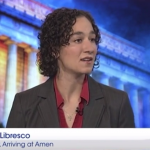
This week, I attended a debate on “Does God Exist?” co-sponsored by the DC branch of the Center for Inquiry and the George Washington University Newman Center. The debate format had alternating speeches by Fr. Carter Griffin and Dr. John Shook, followed by written questions from the audience. The debate was wide ranging, with both speakers talking about the First Mover argument, scriptural authority, the degree of confidence we should have in recent scientific discoveries, the uniqueness of the Christian claim, etc…
The trouble is, the debaters hit a lot of these arguments in every round, so it was hard to address any of them in detail and easy for speakers to accidentally or intentionally rebut points the opponent hadn’t actually made. In competitive debate, a common strategy is to ‘spread’ arguments: bring up as many as possible and then attack your opponent if they don’t manage to rebut all of them within their time limit.
It’s a terrible way to approach truth, but is very easy to score. This is William Lane Craig’s central strategy in his debates with atheists, and Andrew at Evaluating Christianity has written an excellent primer on rhetoric and strategy if you find yourself in this kind of debate.
But I don’t think either of the debaters at Wednesday’s event were necessarily trying to have that kind of debate. So, instead of offering defensive techniques, I want to lay out some preemptive ideas to get the best, most thoughtful debate possible. It’s yet another display of my paternalist tendancies: I want to make it as hard as possible to have a shallow, posturing debate, even if that’s the goal or one or both of the speakers.
[Note, sticking with gender neutral pronouns and trying to keep using synonyms for “speaker” “debater” etc, in the next few paragraphs made it really hard to keep track of the antecedents, so I’m following cryptographic naming conventions and using a hypothetical debate between Alice and Bob]
Debate Format

The standard speech followed by rebuttal format lets debaters off the hook too easily. In each round, I’d like to see the first speaker (Alice) lay out her argument in one speech. Then, instead of giving a rebuttal, Bob would cross-examine her. Bob would be able to ask follow-up questions and immediately correct Alice if she started responding to straw-men instead of Bob’s actual premises. After the cross-examination ended, Alice would give a 1-2 minute recapitulation of her position and expand any defenses that she brought up in the Q&A.
Q&A is a higher stakes format for both debaters. Bob can expose flaws in Alice’s argument more easily, since he can ask her a series of follow-ups designed to lead her into contradiction, but, if he doesn’t understand her position, he may end up embarrassing himself if he asks questions that she can expose as straw-men or misunderstandings. (For example, any question that was premised on the idea Catholics worship the pope or are bound by all of his opinions). It’s a lot easier to grandstand or deceive if your opponent isn’t about to respond to you point-by-point.
This format is asymmetrical; one debater is attacking and one is defending. That’s by design. It can be easy to cheat in a debate by just pummeling your opponent instead of defending your position. As long as the audience buys in to the false choice between the two of you, they treat all evidence against one side as positive evidence for the other side. It’s a bad habit. When I saw Freud’s Last Session, I thought Lewis’s arguments were strong relative to Freud’s, but Freud being wrong didn’t prove Lewis correct.
Debate Content

To avoid the strafing strategy of switching arguments whenever an opponent gains ground, I would limit each round of speech-cross-speech to a single topic. Each participant in the debate should propose several topics. An atheist might propose “The problem of evil,” “The multiplicity of religions,” and “The moral track record of religions.” The Christian might suggest “The first mover problem,” “Finding a foundation for morality,” and “What is the purpose of life.” The moderator/hosting organization could also suggest topics.
Some of these topics might lend themselves to two rounds, where both Alice and Bob needed to defend their position. Some might be rooted in the premises of only one side, (i.e. only the Christian would need be first speaker in a ‘Problem of Evil’ round, since it’s not a problem at all for the atheist). The two debaters would agree on a final list of rounds by negotiating with each other and the moderator, Eve.
This strategy helps quarantine arguments about history from arguments about metaphysics, which helps defuse the common problem of the two sides referencing wildly different standards of evidence in the same round as they jump back and forth between varying levels of abstraction. Negotiating and agreeing on the broad list of topics beforehand also makes it easier to ensure that both debaters will be prepared to argue about the positions of their opponent, not a straw man or a misconception.
Oh, and as one final safe guard, I would recommend always using the same first round topic for both debaters: Epistemology and standards of evidence. It’s a tremendous waste of time when Alice spends an entire speech listing evidence that Bob thinks is prima facie irrelevant. Talk about these schema at the beginning and let that argument color the rest of the debate.
Miscellaneous Shenanigans
I’m on the train right now to head up to Yale for an alumni debate, and I’ve been trying to think what else you can bring in to avoid having debaters fundamentally misunderstanding their opponents or just taking the lazy approach of rallying your own team instead of persuading the other side (or, y’know, actually seeking truth). My college group had an enormous advantage: we were a community. So if you tried to score cheap points off someone at Thursday night’s debate, you’d have to face them at Friday’s lunch. The better we knew each other, the more substantive our questions could be, and the more accountable we were to each other.
You can’t create that kind of mutual respect overnight, but, as a jerry-rigged solution, I’d suggest requiring Alice and Bob to have dinner together before the debate, with or without members of the sponsoring organizations. It makes it that much harder to dehumanize the opponent or the entire opposing side. If you get a better sense of their position, you can drill down on the most fundamental points of disagreement by the time you take your places at the rostrum.











